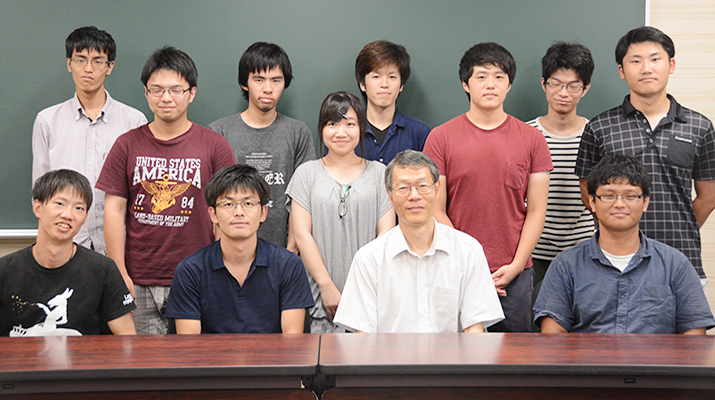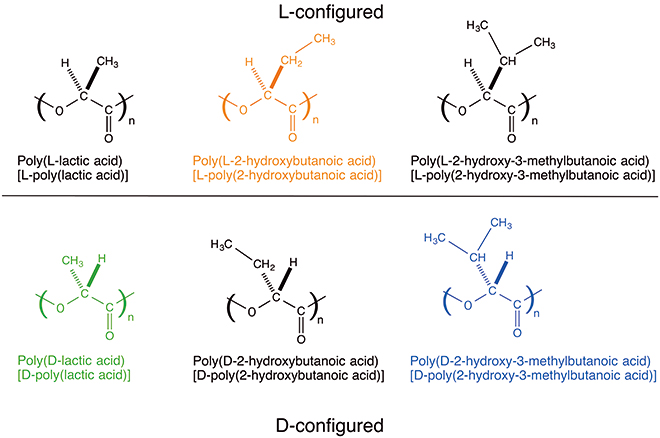
ここからコンテンツです。

Discovery of "Helical Molecular Glue"
A counterclockwise-helical molecule glues two structurally-different clockwise-helical molecules together By Hideto Tsuji
Professor Hideto Tsuji and his colleagues have made a world-first discovery of the "molecular glue" action of a counterclockwise-helical molecule to glue two structurally-different clockwise-helical molecules together. This discovery was announced on March 24, 2017 in Scientific Reports. To bind two polymers coiled in the same direction was previously considered impossible. Consequently, the degree of freedom in polymer combination has increased, and development of new polymer materials with various properties has become possible.
The research group led by Professor Hideto Tsuji conducts basic and applied researches on biodegradable polymers derived from renewable resources such as corn or potato starch. The group mainly studies a typical biodegradable polymer poly (lactic acid). Poly (lactic acid) is hydrolyzed and degraded in the human body and the resulting lactic acid is metabolized without causing adverse effects to the body. Because of this advantage, poly (lactic acid) is used in medical applications as a scaffold material for tissue regeneration and also in environmental applications.
Poly (lactic acid) contains an asymmetric carbon and therefore occurs either as the L- or D- enantiomer, namely poly (L-lactic acid) or poly (D-lactic acid) (Fig. 1). Since the interaction between different enantiomers (i.e. between L and D) is stronger than that between the same enantiomers (e.g. between D and D), blending the two enantiomers results in co-crystallization of an L-enantiomer and a D-enantiomer (this phenomenon is also called stereocomplex formation). The stereocomplex has a higher melting point, better mechanical properties, and higher heat resistance and hydrolysis resistance than those of their constituent enantiomers, and therefore the stereocomplex may have wider applications than those of conventional biodegradable materials. Under these circumstances, stereocomplex formation between poly (lactic acid) has been actively researched in recent years.

L-poly (lactic acid) is counterclockwise-helical, and D-poly (lactic acid) is clockwise-helical. Therefore, the fact that L-poly (lactic acid) and D-poly(lactic acid) form a stereocomplex together indicates that a counterclockwise-helical molecule and a clockwise-helical molecule are strongly attracted to each other. Tsuji et al. have also discovered that blending the L- and D-enantiomers of poly (2-hydroxybutanoic acid) (Fig.1) (a poly (lactic acid) with its methyl group replaced by an ethyl group) results in stereocomplex formation as well. In addition, there are reports of the same phenomena occurring to poly (2-hydroxy-3-methylbutanoic acid) (Fig.1) (a poly (lactic acid) with its methyl group replaced by an isopropyl group) and occurring even between poly (lactic acid) with different side chains (for example, between L-poly (lactic acid) and D-poly (2-hydroxybutanoic acid)). All these phenomena indicate the presence of strong interaction between a counterclockwise-helical molecule and a clockwise-helical molecule.

This time, Tsuji et al. have discovered that a counterclockwise-helical molecule can glue two structurally-different clockwise-helical molecules that would not otherwise bind together (Fig.2). This finding indicates that a clockwise-helical molecule may have a similar effect on two structurally-different counterclockwise-helical molecules. Through experiment using D-poly (lactic acid), L-poly (2-hydroxybutanoic acid), and D-poly (2-hydroxy-3-methylbutanoic acid), Tsuji et al. have made a world first breakthrough by demonstrating that counterclockwise-helical L-poly(2-hydroxybutanoic acid) acts as “helical molecular glue” to glue clockwise-helical D-poly (lactic acid) and clockwise-helical D-poly (2-hydroxy-3-methylbutanoic acid). This process co-crystallizes these two D-molecules which would normally resist co-crystalization. This finding has opened the door to binding various polymers that are coiled in the same direction. Now that the degree of freedom in polymer combination has increased, development of new polymer materials with various properties has become possible.
This work was supported by
- JSPS Grant-in-Aid for Scientific Research No. 16K05912
- MEXT (Ministry of Education, Culture, Sports, Science and Technology) Grant-in-Aid for Scientific Research No. 24108005
Reference
Hideto Tsuji, Soma Noda, Takayuki Kimura, Tadashi Sobue, and Yuki Arakawa, Configurational Molecular Glue: One Optically Active Polymer Attracts Two Oppositely Configured Optically Active Polymers, Scientific Reports, vol. 7, Article number 45170 (2017). http://www.nature.com/articles/srep45170 (open access)
「らせん型分子接着剤」の発見
−「左巻き」分子は、異なる2種類の「右巻き」分子の「接着剤」として働く−辻秀人教授らは、「左巻き」の分子が、異なる化学構造を有する2種類の「右巻き」をくっつける「分子接着剤」として働くことを世界で初めて発見しました。本研究成果は、Nature Publishing Groupの発行するScientific Reportsに2017年3月24日に掲載されました。本研究成果により、従来は組み合わせることが不可能であった、同一方向のらせん構造を有する種々の異なる2種類の高分子を組合せることができるようになり、様々な特性を有する高分子材料の開発を可能にすることが期待されます。
辻秀人教授らの研究グループでは、トウモロコシあるいはジャガイモ由来のデンプンなど、再生可能資源からの生産が可能である「ポリ乳酸」を中心とする「生分解性高分子」に関する基礎および応用研究を行なっています。ポリ乳酸は、代表的な生分解性高分子であり、生体内で加水分解され、分解生成物の乳酸は人体に悪影響を及ぼすことなく代謝されます。このような特性を利用して、組織再生の足場材料など医療用途や環境用途で用いられています。
不斉炭素をもつポリマーであるポリ乳酸には、鏡像関係にあるL体のポリ(L-乳酸)とD体のポリ(D-乳酸)が存在します(図1)。これらをブレンドするとL体どうし、あるいはD体どうしの相互作用よりも、L体とD体の相互作用が強いために、「ステレオコンプレックス」と呼ばれる「共晶」が形成されます。ステレオコンプレックスを形成すると、単独の場合と比較して、融点が上昇し、力学的特性、耐熱性、および耐加水分解性が上昇します。そのため、従来は「生分解性材料」ですが、「ステレオコンプレックス」化により、幅広い用途への展開が可能となります。そのため、近年、ポリ乳酸の「ステレオコンプレックス」化の研究は盛んに行なわれています。
この例のように、ポリ乳酸のL体とD体は、「左巻き」分子と「右巻き」分子の関係にありますので、「左巻き」分子と「右巻き」分子は強く引き合うことを示しています。ポリ乳酸の「メチル基」が「エチル基」に置換された置換型ポリ乳酸の一種であるポリ(2-ヒドロキシ酪酸)(図1)のL体とD体をブレンドすることにより「ステレオコンプレックス」が形成されることも発見していますが、ポリ乳酸の「メチル基」が「イソプロピル基」に置換された置換型ポリ乳酸のポリ(2-ヒドロキシ-3-メチル酪酸) (図1)でも同様の現象が報告されています。さらに同様の現象は分子の側鎖の種類が異なっていても起こり(例えば、ポリ乳酸のL体とポリ(2-ヒドロキシ酪酸)のD体)、これらの結果も「左巻き」分子と「右巻き」分子が強く引き合うことを示しています。
今回の発見は、「左巻き」分子が、従来は組み合うことのない、異なる化学構造を有する2種類の「右巻き」分子をくっつける「接着剤」として働くというものです(図2)。このことは、「右巻き」の分子も、従来は組み合うことのない、異なる化学構造を有する2種類の「左巻き」の分子をくっつける「接着剤」として働くことを意味しています。今回発見した組合わせは、D体のポリ乳酸、L体のポリ(2-ヒドロキシ酪酸)、D体のポリ(2-ヒドロキシ-3-メチル酪酸)です。「左巻き」のらせん構造を有するL体のポリ(2-ヒドロキシ酪酸)が、「右巻き」のらせん構造を有するD体のポリ乳酸およびD体のポリ(2-ヒドロキシ-3-メチル酪酸)をくっつける「らせん型分子接着剤」として働き、通常は共に結晶を作らないD体のポリ乳酸およびD体のポリ(2-ヒドロキシ-3-メチル酪酸)をくっつけ一緒に結晶を作ることを世界で初めて発見しました。本手法を用いることにより、従来は組み合わせることが不可能であった、同一方向のらせん構造を有する種々の異なる2種類の高分子を組合せることができるようになり、様々な特性を有する新しい高分子材料の開発を可能にすることが期待されます。
本研究は以下の助成を受けて行われました。
- JSPS科研費 No. 16K05912
- 文部科学省科研費 No. 24108005
Researcher Profile

| Name | Hideto Tsuji |
|---|---|
| Affiliation | Department of Environmental and Life Sciences |
| Title | Professor |
| Fields of Research | Plant-Based Polymers/ Biodegradable Polymers |
ここでコンテンツ終わりです。
